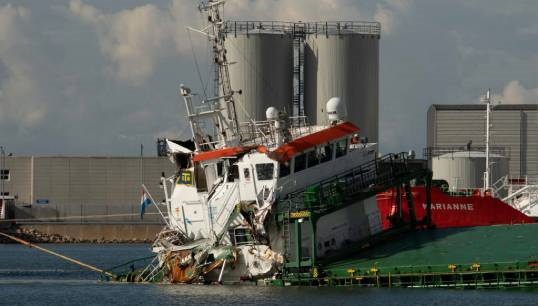- Topics
- Campaigning
- Careers
- Colleges
- Community
- Education and training
- Environment
- Equality
- Federation
- General secretary message
- Government
- Health and safety
- History
- Industrial
- International
- Law
- Members at work
- Nautilus news
- Nautilus partnerships
- Netherlands
- Open days
- Opinion
- Organising
- Podcasts from Nautilus
- Sponsored content
- Switzerland
- Technology
- Ukraine
- United Kingdom
- Welfare

Following an investigation into a collision which nearly sank a Netherlands-flagged ship, the Dutch Safety Board has urged shipmasters to ensure that lookouts are posted at night. Andrew Linington reports
Back in September 2022, the 2,911gt general cargoship Helge – which was carrying 4,400 tonnes of ammonium sulphate – had to be abandoned after it was hit by the 9,859gt Bahamas-flagged reefer Wild Cosmos off the coast of Denmark.
Helge's seven crew members managed to escape, uninjured, in a liferaft and were airlifted ashore by helicopter. Salvors managed to prevent the badly damaged vessel from sinking and it was towed to the Danish port of Esbjerg.
In a report on the incident, the Dutch Safety Board said the causes were very similar to many other collisions it has investigated and it stressed the need for seafarers to make proactive and correct use of onboard technology.
Investigations revealed that both ships were operating with a lone officer on the bridge, even though the collision occurred during the hours of darkness.
The Helge's chief officer had made a decision based on a single AIS observation of Wild Cosmos when the ships were about five miles apart that there was no risk of collision.
He had been doing administrative work at the time of the collision, the report notes, and had been so distracted by the paperwork that he was not looking at the radar or the ECDIS.
Similarly, the chief officer on Wild Cosmos – who told investigators that he had not seen the Dutch ship – had also made decisions based mainly on what he saw on the radar. He had failed to use available information from the AIS, the report adds, or to 'structurally look outside to check if he saw anything there which might not have shown up on the radar'.
Wild Cosmos, which was sailing from South Africa to Russia with a cargo of fruit, was overtaking Helge when the collision occurred. Helge's chief officer had assumed the overtaking ship would stay clear and he had failed to use two radars to track it. The closest point of approach alarm on the AIS did not sound, as it had been turned off.

Investigators said the chief officer's forward view from his seat on the bridge of the Wild Cosmos was partially blocked by the ship's cranes. The position of the chair also made it difficult for him to see both radar screens properly and he had also failed to set the CPA alarm on the AIS.
The Dutch Safety Board said the incident had shown the risks arising when routine checks and double checks are not performed. 'It is important for seafarers to remain aware of human limitations,' the report adds. 'Especially when there is an impression that everything is under control, there is a danger that a situation may not be accurately assessed.
'Factors contributing to this can include sleep deprivation, monotony, distraction, disruption of day-night rhythms, and singlehanded watchkeeping,' it points out. 'Recognising these limitations is one of the key aspects of good seamanship.'
Calling for industry organisations and training institutes to bring the lessons from the accident to the attention of their members, the Board said the case also highlighted the importance of ensuring that bridge resource management is properly applied onboard.
Tags
More articles
European safety stays on course
Fire onboard MPV Everest highlights risks and challenges of operating in the Southern Ocean
A report issued by the Australian Transport Safety Bureau highlighted the challenges and risks associated with operating in harsh, remote conditions following a fire onboard a multi-purpose vessel chartered by the Australian Antarctic Division while it transited the Southern Ocean.
Red Sea attacks: your questions answered
UK maritime pilots get a safe health haven with dedicated wellbeing support scheme
UK maritime pilots now have access to their own dedicated mental health and wellbeing support thanks to a partnership between Sailors' Society and the UK Maritime Pilots' Association (UKMPA).
